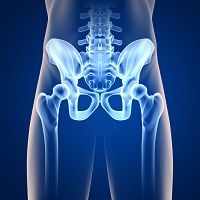Article
Hip Replacement Is an Option for Patients with Juvenile Idiopathic Arthritis
Author(s):
Study results show good outcomes for hip replacement in patients under age 35 diagnosed with juvenile idiopathic arthritis who have failed to respond to previous treatment.

When you think of hip replacement surgery, you generally envision an older adult with painful osteoarthritis. But the procedure is also used for younger patients with juvenile idiopathic arthritis (JIA) whose joints have been severely damaged by the disease.
A new study by Hospital for Special Surgery (HSS) researchers finds that total hip replacement (THR) is an excellent option for patients under age 35 when conservative treatments fail to provide relief.
The study, presented at the American College of Rheumatology annual meeting on November 16, found that hip replacement lasted at least 10 years in 85 percent of JIA patients. Twenty years out, 50 percent of the patients needed a revision surgery, or second hip replacement.
Juvenile idiopathic arthritis is a common rheumatologic disease in children that often persists into adulthood. It frequently affects the hip joint, and total hip replacement is the standard treatment to relieve pain and restore mobility when nonsurgical treatments no longer help.
"The surgery in this patient population, although performed by only a small number of specialized orthopedic surgeons nationwide, is life-changing for JIA patients," said Mark P. Figgie, MD, senior author of the study and chief of the Surgical Arthritis Service at HSS. "Joint replacement can free patients from a life of unrelenting pain. It can enable those in a wheel chair to walk again. Patients can go back to school or work and get their lives back."
This study, titled, "Implant Survival and Patient-Reported Outcomes after Total Hip Arthroplasty in Young Patients with JIA," evaluated the longevity of implants in JIA patients ages 35 or younger who underwent hip replacement at Hospital for Special Surgery.
"This study followed one of the largest cohorts of patients with JIA to see how they fared 10 years and 20 years after total hip replacement," said Ishaan Swarup, MD, an orthopedic surgery resident at HSS. "It is also one of the few studies to look at patient-reported measures, such as pain and the ability to perform activities of daily living."
Patient characteristics and implant data were collected by a retrospective chart review and follow-up surveys were conducted. Kaplan-Meier survival analysis was performed to evaluate how long the implant lasted, and the hip disability and osteoarthritis outcome score (HOOS) was used to describe patient-reported outcomes.
Data were collected for 56 patients. Forty-one patients had undergone bilateral hip replacement, while 15 individuals had only one side replaced, for a total of 97 hip replacement surgeries. The mean time for follow-up was 12 years. The 10-year and 20-year implant survival was 85 percent and 50 percent, respectively.
The researchers found that hip replacement in patients who were 25 or older lasted longer compared to THR in younger patients. There were no other significant differences in implant longevity based on gender or the use of custom versus standard implants.
Male patients reported better outcomes with respect to activities of daily living, and patients who had received custom hip implants did worse in their reporting of pain and the ability to perform daily activities.
"We were not surprised that the patients who received custom implants had lower scores, since the very fact that they needed a custom implant meant they had more severe joint deformities and more severe disease," Figgie explained.
"We concluded that overall, hip replacement is an excellent treatment option for young JIA patients with reasonable long-term implant survival and favorable patient-reported outcomes after surgery," Swarup said.
Although a good treatment, Figgie noted that the longevity of the implants needs to be improved, especially since the patients are so young. "The next step will be to evaluate which factors affect how long the implants last and work on improving implant design and durability," he said.
Source: Hospital for Special Surgery





